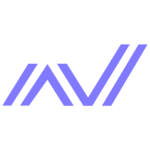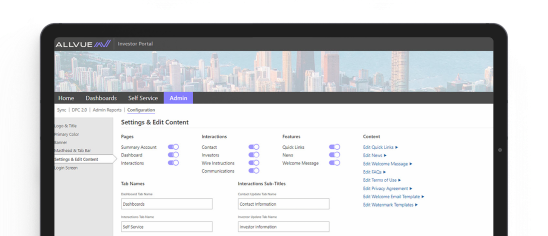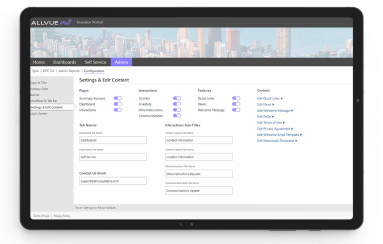
By: Allvue Team
September 18, 2025
As private capital fund operations have moved from printed out reports to faxed copies to email attachments, one thing hasn’t really changed — the chaos of trying to keep all of that information contained and neatly organized for fund managers and investors to easily access. With modern investor portals, however, change has finally arrived, and it’s certainly for the better.
Modern investor portals act as 24/7 hubs for both GPs and LPs, allowing them to view and manage a variety of real-time information and communications. That includes access to performance reports, investment updates, financial statements, communication history, and a whole swath of additional data. That said, whether you’re late to the portal party or have been unimpressed by your current setup, it’s important to know that not every investor portal is made equal.
Here, we’ll guide you on how to choose customizable investor solutions, including why customization is key for any successful investor portal, features to prioritize, questions to ask, and how to enhance the LP experience. Let’s get into it!
Why Customization Matters in Investor Portals
“One size fits all” sounds nice…until you realize that your LPs don’t just want something that fits — they want something that fits perfectly. In order to achieve the perfect fit, customization is a must. Here’s why.
Meeting LP Expectations for Transparency and Control
LPs are no longer content with periodic updates. Expectations have grown, and LPs are increasingly looking for self-service access to real-time data, reports, and performance metrics. With custom portals, these demands fortunately work in favor of both LPs and GPs, as they 1. provide the needed level of transparency and control for LPs to access data and run their own reports; and 2. reduce the time GPs have to spend fulfilling fetch and deliver tasks. The customization aspect of a portal is particularly important for empowering GPs to meet these evolving LP demands, and doing so without overburdening IR teams.
For example, instead of fielding one-off requests, IR teams can configure the portal to display selected key performance indicators (KPIs), automatically schedule report deliveries, or provide tailored dashboards for different investor segments. Customization ensures that LPs see the metrics that matter most to them, ultimately improving transparency and building trust.
Adapting to Unique Fund Structures and Reporting Needs
Funds come in all shapes and sizes, varying in structure, geography, and compliance requirements. Because of that, portals need to be flexible enough to cater to specific needs, rather than try and force everything into a predetermined cookie-cutter presentation. Portals need to be customizable in order to allow for tailored investor reporting formats, document views, and dashboards that meet unique needs.
Going a step further, adaptability isn’t just about the initial creation. While a number of portal platforms can meet current needs, it’s easy to forget that tomorrow’s needs (and beyond) are just as important. That means not only having customization on day one, but also the flexibility to continue adjusting customizations as funds grow or diversify.
Key Features to Look for in a Customizable Investor Portal
Like we said from the start, not all portals are made equal. If you’re looking to find a modern, customizable investor portal that delivers real value and offers flexibility, security, and integration, here are the features you should consider “must-haves.”
Branding and White-Labeling Capabilities
One of the most important aspects of building a brand is creating an identity that is consistent and recognizable anywhere people encounter your services — including an investor portal. It might not sound all that important, but a portal that’s fully white-labeled with your fund’s branding reinforces a level of professionalism that can help build trust and strengthen brand identity.
When looking at customizable portals, make sure there’s an expansive offering of white-labeling capabilities. That includes allowing you to create customizable logos, color schemes, domain names, and even smaller details like welcome messages.
Role-Based Access Controls and Security
Not every user needs access to everything. In fact, it’s just plain old bad security to do so. Rather than widespread emails and floating files, investor portals help centralize information and provide a system that allows for precise access controls. These controls can provide exact parameters on who can see what, ensuring LPs, fund admins, and internal teams have the appropriate levels of access where they need it (and only where they need it).
In order to ensure proper data privacy and compliance, make sure any portal you look at offers the following features:
- Two-factor authentication
Seamless Data Integration Across Systems
You may have noticed the term “centralized” pop up a few times already — that’s because investor portals don’t operate in isolation. In order to provide one spot for GPs and LPs to see everything they need, investor portals need to seamlessly integrate across all systems. They should connect everything from fund accounting software, CRM platforms, and other back-office systems.
More specifically, prioritize portals with open APIs and compatibility with major systems. This integration reduces manual data entry, improves accuracy, and saves time, freeing up your team to focus on high-value activities rather than administrative work.
Choosing the Right Investor Portal Vendor
Once you have the standout features identified, selecting the best-fit vendor still takes careful evaluation. Knowing common pitfalls and asking the right questions upfront can save time, money, and future headaches.
Questions to Ask During the Evaluation Process
Before locking in with just any vendor, be sure to ask the following questions:
- How customizable is the platform, really? Ensure the portal can be fully built around your brand, as well as your current and future needs. A good follow-up to this question is to ask for any demos showing the ability to meet specific needs.
- What support is available during implementation? Make sure you understand the onboarding process, training resources, and ongoing support being offered.
- Does the vendor have experience with your fund type/size? Look for providers who understand the needs that are more tailored to your sector.
- Is there a product roadmap for future enhancements? A portal should evolve alongside your fund. Ask about upcoming features, updates, and long-term vision.
Avoiding Common Implementation Pitfalls
Even the portals with the best technical capabilities can fall short if the implementation process isn’t handled with the proper oversight. When it comes time to get your portal up and running, watch out for these common pitfalls (and check out some tips on how to avoid them):
- Underestimating training needs: Ensure your team (and LPs, if needed) get hands-on training and support.
- Overlooking integration requirements: Map out how the portal will connect with existing systems upfront.
- Choosing a rigid system that can’t scale: Select a solution that can grow with your fund’s complexity, rather than just picking one that works for right now.
Enhancing the LP Experience Through Personalization
Everyone has their own preferred way of doing things. With proper personalization features, LPs gain the power to shape and control what they see and how they see it, allowing them to zero in on the information that matters most.
Custom Dashboards and On-Demand Reporting
LPs shouldn’t have to click a million tabs or sift through emails like archaeologists at a dig site to see the data they want. With custom dashboards, all of the information they want to view should be readily visible in a way that works best for them. Whether that be highlighting performance snapshots, capital call history, real-time NAV updates, or visualizing allocations through model portfolios, the fewer barriers involved, the higher the performance and satisfaction. And, as an added bonus, unnecessary back and forth is done away with, meaning less time spent fielding inbound questions and more time focusing on the important stuff.
Improving Investor Engagement and Satisfaction
Beyond the efficiency of a customizable dashboard, personalizations such as tailored communications around each LP’s name, fund focus, and activity level can go a long way in building trust. Look for platforms that allow message templates, segmented messaging, and user preferences to ensure each investor receives timely, relevant updates. Not only does this enhance the investor experience, but it can lead to stronger relationships, reduced errors, and ultimately higher LP retention.
Scaling Communication with Automation and Insights
As your fund grows, so does the complexity of keeping investors informed. Automation and data-driven insights make it possible to scale communication without sacrificing personalization or precision.
Scheduled Reporting and Alerts
Staying on top of capital call notices, quarterly reports, and compliance alerts is critical, but managing these tasks manually can be time-consuming and prone to error. By automating these communications, GPs ensure that investors receive timely, accurate updates without the need for constant manual oversight. Look for platforms that allow scheduling by investor, fund, or geography, so you can tailor delivery to different stakeholder needs. This automation ensures consistency, timeliness, and compliance across jurisdictions, as well as being easily adaptable alongside growth and changes.
Tracking Investor Behavior and Portal Usage
One of the bigger advantages of a modern investor portal is the insight it provides into LP behavior. Tracking which documents are most viewed, how frequently LPs log in, and which reports are downloaded can offer valuable signals about investor priorities and concerns.
Armed with this data, GPs can tailor future communications, anticipate questions, and identify opportunities to enhance service. For example, if a particular metric or report is seeing high engagement, consider spotlighting it in your next investor update.
Choosing the Best Investor Portal for Long-Term Success
Choosing the right investor portal software solution is more than simply finding a technology vendor. It’s about setting up your fund for long-term success. From white-label branding that reinforces your firm’s identity, to secure, role-based access controls that protect sensitive information, to seamless integration with existing systems — having the right features can make all the difference in strengthening investor relationships, streamlining operations, and helping your team stay ahead in an increasingly competitive market.
When it comes time to evaluate vendors, carefully look for a partner that is going to offer you the flexibility, scalability, and support you need. Prioritize vendors with proven track records, like Allvue Systems, whose platforms are designed to grow alongside your fund and help you meet evolving investor expectations.
To learn more, check out Allvue and request a demo to see how a modern investor portal can elevate your fund operations!

